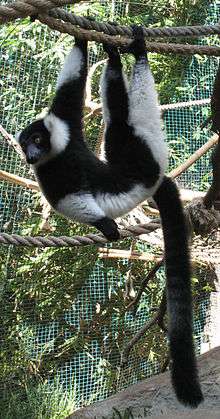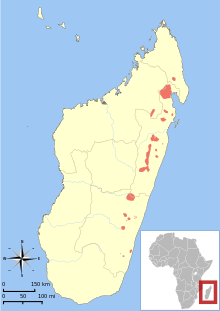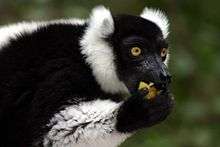Black-and-white ruffed lemur
| Black-and-white ruffed lemur | |
|---|---|
 | |
| Scientific classification | |
| Kingdom: | Animalia |
| Phylum: | Chordata |
| Class: | Mammalia |
| Order: | Primates |
| Suborder: | Strepsirrhini |
| Family: | Lemuridae |
| Genus: | Varecia |
| Species: | V. variegata |
| Binomial name | |
| Varecia variegata Kerr, 1792[3] | |
| Subspecies | |
|
V. v. variegata (Kerr, 1792) | |
 | |
| Distribution of Varecia variegata[1] | |
| Synonyms | |
|
V. v. variegata:
| |
The black-and-white ruffed lemur (Varecia variegata) is the more endangered of the two species of ruffed lemurs, both of which are endemic to the island of Madagascar. Despite having a larger range than the red ruffed lemur, it has a much smaller population that is spread out, living in lower population densities and reproductively isolated. It also has less coverage and protection in large national parks than the red ruffed lemur. Three subspecies of black-and-white ruffed lemur have been recognized since the red ruffed lemur was elevated to species status in 2001.[5]
Together with the red ruffed lemur, they are the largest extant members of the family Lemuridae, ranging in length from 100 to 120 cm (3.3 to 3.9 ft) and weighing between 3.1 and 4.1 kg (6.8 and 9.0 lb).[6] They are arboreal, spending most of their time in the high canopy of the seasonal rainforests on the eastern side of the island. They are also diurnal, active exclusively in daylight hours. Quadrupedal locomotion is preferred in the trees and on the ground, and suspensory behavior is seen during feeding. As the most frugivorous of lemurs, the diet consists mainly of fruit, although nectar and flowers are also favored, followed by leaves and some seeds.[7]
The black-and-white ruffed lemur has a complex social structure and is known for its loud, raucous calls.[5] It is unusual in that it exhibits several reproductive traits typically found in small, nocturnal lemurs, such as short a gestation period, large litters and rapid maturation.[7] In captivity, they can live up to 36 years.[8]
Taxonomic classification
The black-and-white ruffed lemur is one of two species within the genus Varecia, and has three subspecies. Of the three subspecies, the white-belted black-and-white ruffed lemur (Varecia variegata subcincta) is found furthest to the north,[9] the southern black-and-white ruffed lemur (Varecia variegata editorum) is found furthest to the south,[10] and the black-and-white ruffed lemur (Varecia variegata variegata) has a geographic range between the other two subspecies.[11]
- Family Lemuridae
- Subfamily Lemurinae
- Genus Lemur: the ring-tailed lemur
- Genus Eulemur: brown lemurs
- Genus Varecia: ruffed lemurs
- Black-and-white ruffed lemur, Varecia variegata
- Variegated black-and-white ruffed lemur (or pied black-and-white ruffed lemur), Varecia variegata variegata
- Southern black-and-white ruffed lemur (or Hill's black-and-white ruffed lemur), Varecia variegata editorum
- Northern black-and-white ruffed lemur (or white-belted black-and-white ruffed lemur), Varecia variegata subcincta
- Red ruffed lemur, Varecia rubra
- Black-and-white ruffed lemur, Varecia variegata
- Subfamily Hapalemurinae: bamboo lemurs
- Subfamily Lemurinae
Anatomy and physiology

The black and white lemur is always both black and white, their general color patterns do not usually vary. The black-and-white ruffed lemur (V. v. variegata) abdomen, tail, hands and feet, inner limbs, forehead, face and crown are black. Pelage is white on the sides, back, hind limbs and on the hindquarters. Males and females look the same.[12]
Behavior
Female dominance
Black-and-white ruffed lemurs demonstrate the rare behavior of female social dominance both within and outside the context of feedings. This is also found in other ruffed lemurs as well as in ring-tailed lemurs. Aggressive interactions between males and females are usually won by the female even when they do not show aggressive behavior towards the male. Unlike other species of lemurs, black-and-white ruffed lemur females occasionally show submission and more aggression needs to be maintained in order for the female to win the interaction instead of having an undecided interaction. Male aggression does not vary among seasons.[13]
One of the main reasons that black-and-white ruffed lemurs exhibit dominance is for feeding purpose; that is they are able to establish priority over males in feeding. Reproductive females need more access to food because of the costs of carrying and caring for offspring which is why they establish this feeding priority. Energy demands in this species are particularly high. Female dominance in feeding is maintained through demonstrating some aggressive behavior and leading the group to food in order to have first access to the food. Dominance is not thought to be established in younger females so groups lacking a mature female may not have a dominant female. When a dominant female is present, she leads the group to the food source and eats more than the rest of the group.[14]
Communication
The black-and-white ruffed lemur demonstrates several different call types each of which last several seconds. Most lemurs of a group participate in any one chorus. These lemurs are particularly known for their loud roar/shriek choruses which have several purposes including group movement, spacing among different groups, and alarming other members of the group of predators. Unlike the calls of other species, the calls of the black-and-white ruffed lemur are not likely to be for the establishment of territory for a group. The calling behavior is participated in throughout the course of a day, not concentrated at any one point of the day; however calls are usually not heard at night.[15]
Interspecific interactions
Black-and-white ruffed lemurs are known to form a natural hybrid zone with the red-ruffed lemur. This zone may have once been very large before humans came into contact with the two subspecies. The calls of the two organisms differ in frequency and pulse rate.[16]
Social structure
Studies of groups of black-and-white ruffed lemurs both in captivity and in the wild have demonstrated a variety of social structures from pairs to large groups. Parenting in this species of lemurs is unique in that no single infant is invested in but instead, females bear litters of multiple offspring. Males also play a role in the parenting of the offspring especially in smaller groups where the certainty of paternity is high. In larger groups, the chance of a female mating with more than one male increases as does uncertainty in paternity. This tends to decrease the level of male care of offspring. Instead of clinging to the mother, offspring are placed into a nest which is guarded by both parents.[17]
Threats in the wild
While predators may be a large threat to the black and white ruffed lemur, the principal threat to their survival comes from the human inhabitants of the island. Since they are comparatively large to other species of lemurs they are hunted for their meat by poachers and village men who are looking to feed their families. Another threat to the lemurs is the agricultural practices of the local community. The slash and burn method of agriculture is very devastating to the natural habitat of the black and white ruffed lemur.
The black-and-white ruffed lemur is preyed upon by the Henst's goshawk (Accipiter henstii), fossa (Cryptoprocta ferox), ring-tailed mongoose (Galidia elegans) and brown-tailed mongoose (Salanoia concolor). Nesting behavior poses the greatest risks for predation, especially mammalian predators.
Geographic location
The black-and-white ruffed lemur is naturally found in the eastern Madagascar rainforest. Three subspecies reside amongst Madagascar’s rainforest; they are the Varecia variegata subcinta, Varecia variegate editorum, and the black-and-white ruffed lemur (Varecia variegata variegata). The subspecies of the Varecia variegata variegata normally can be found inhabiting areas of the rainforest below the Anove River, and between Ambatovaky Reserve and the Zahaman National Park.
Ecology
Ruffed lemurs are the most frugivorous of all the lemur species, they will and often do feed on over 80 to 132 different plant species. Studies show that most of their feeding time is spent on basic fruit which consumes around 80% of that time. The rest of which is spent mostly on nectar and various other forage. In general most male black and white ruffed lemurs will eat less than a female will during the hot dry seasons of Madagascar. Another difference between the diet of male and female ruffed lemurs is that when a female is pregnant and also lactating she will eat significantly more flowers and leaves than the male in order to supply her child and the high energy cost of reproduction. Of the general plants they eat, the most common types are Canarium (Burseracea), Cryptocarya, Ocotea, Ravensara (Lauraceae), Ficus (Moraceae), Eugenia/Syzygium (Myrtaceae), and Grewia (Tiliaceae). Studies recording ruffed lemurs in captivity and in the wild over the course of a year show that ruffed lemurs on an average spend around 28% of their time feeding, 53% resting, and the last 19% socializing and moving about.
Population
The Varecia variegata population is on a steep downward trend, dropping 80% in the last 27 years. The Vasey studies in 2003 indicated that Nosy Mangabe is the most densely populated area of black and white ruffed lemurs. It had around 29–43 individuals/km2. Next in decreasing order came Anatanamatazo with 10–15 individuals/km2, and then Manomba with.4-2.5 individuals/km2.
References
- 1 2 Andriaholinirina, N.; et al. (2014). "Varecia variegata". IUCN Red List of Threatened Species. Version 2014.1. International Union for Conservation of Nature. Retrieved 2014-06-16.
- ↑ "Checklist of CITES Species". CITES. UNEP-WCMC. Retrieved 18 March 2015.
- ↑ Groves, C.P. (2005). Wilson, D.E.; Reeder, D.M., eds. Mammal Species of the World: A Taxonomic and Geographic Reference (3rd ed.). Baltimore: Johns Hopkins University Press. p. 117. OCLC 62265494. ISBN 0-801-88221-4.
- ↑ Groves, C.P. (2005). Wilson, D.E.; Reeder, D.M., eds. Mammal Species of the World: A Taxonomic and Geographic Reference (3rd ed.). Baltimore: Johns Hopkins University Press. OCLC 62265494. ISBN 0-801-88221-4.
- 1 2 Mittermeier, R.A.; et al. (2006). Lemurs of Madagascar (2nd ed.). Conservation International. pp. 303–320. ISBN 1-881173-88-7.
- ↑ Garbutt, Nick (2007). Mammals of Madagascar, A Complete Guide. A&C Black Publishers. pp. 170–173. ISBN 978-0-300-12550-4.
- 1 2 Sussman, R.W. (2003) [1999]. Primate Ecology and Social Structure. Vol. 1: Lorises, Lemurs, and Tarsiers (Revised 1st ed.). Pearson Custom Publishing. pp. 195–200. ISBN 0-536-74363-0.
- ↑ Gron, KJ (17 August 2007). "Primate Factsheets: Ruffed lemur (Varecia) Taxonomy, Morphology, & Ecology". Wisconsin Primate Research Center (WPRC). Retrieved 19 September 2008.
- ↑ Andrainarivo, C.; Andriaholinirina, V. N.; Feistner, A.; Felix, T.; Ganzhorn, J.; Garbutt, N.; Golden, C.; Konstant, B.; Louis Jr., E.; Meyers, D.; et al. (2008). "Varecia variegata ssp. subcincta". IUCN Red List of Threatened Species. Version 2008. International Union for Conservation of Nature. Retrieved 3 May 2009.
- ↑ Andrainarivo, C.; Andriaholinirina, V. N.; Feistner, A.; Felix, T.; Ganzhorn, J.; Garbutt, N.; Golden, C.; Konstant, B.; Louis Jr., E.; Meyers, D.; et al. (2008). "Varecia variegata ssp. editorum". IUCN Red List of Threatened Species. Version 2008. International Union for Conservation of Nature. Retrieved 3 May 2009.
- ↑ Andrainarivo, C.; Andriaholinirina, V. N.; Feistner, A.; Felix, T.; Ganzhorn, J.; Garbutt, N.; Golden, C.; Konstant, B.; Louis Jr., E.; Meyers, D.; et al. (2008). "Varecia variegata ssp. variegata". IUCN Red List of Threatened Species. Version 2008. International Union for Conservation of Nature. Retrieved 3 May 2009.
- ↑ Gron KJ. (2007-0817). Primate Factsheets: Ruffed lemur (Varecia) Taxonomy, Morphology, & Ecology. primate.wisc.edu
- ↑ Raps, Stefan & White, Frances J. (1995). "Female Social Dominance in Semi-Free-Ranging Ruffed Lemurs (Varecia Variegata)" (PDF). Folia Primatologica. 65 (3): 163–8. doi:10.1159/000156883. PMID 8792616.
- ↑ Overdorff, Deborah J.; Erhart, Elizabeth M. & Mutschler, Thomas (2005). "Does Female Dominance Facilitate Feeding Priority in Black-and-white Ruffed Lemurs (Varecia variegata) in Southeastern Madagascar?" (PDF). American Journal of Primatology. 66 (1): 7–22. doi:10.1002/ajp.20125. PMID 15898069.
- ↑ Geissmann, Thomas & Mutschler, Thomas (2006). "Diurnal Distribution of Loud Calls in Sympatric Wild Indris (Indri indri) and Ruffed Lemurs (Varecia variegata): Implications for Call Functions" (PDF). Primates; journal of primatology. 47 (4): 393–6. doi:10.1007/s10329-006-0189-5. PMID 16736264.
- ↑ Vasey, Natalie and Tattersall, Ian (2002) "Do Ruffed Lemurs Form a Hybrid Zone? Distribution and Discovery of Varecia, with Systematic and Conservation Implications." American Museum Novitates 3376.1.
- ↑ White, F. J.; Balko, E. A.; Fox, E. A. (1993). "Male transfer in captive ruffed lemurs, Varecia variegata variegata". In Kappeler, P. M.; Ganzhorn, J. U. Lemur Social Systems and their Ecological Basis (PDF). Plenum. pp. 41–49.
External links
| Wikimedia Commons has media related to black-and-white ruffed lemur. |
| Wikispecies has information related to: black-and-white ruffed lemur |
- ARKive – images and movies of the ruffed lemur (Varecia variegata)
- Parco Zoo Punta Verde The black and white ruffed lemur – Varecia variegata
- black-and-white ruffed lemur at Animal Diversity Web
- Black-and-white ruffed lemur
